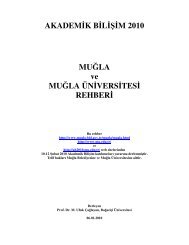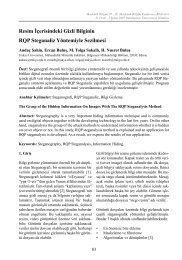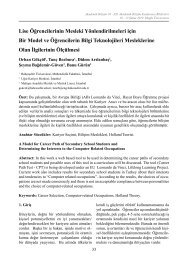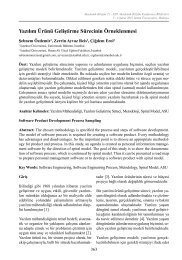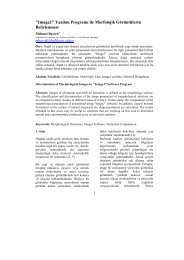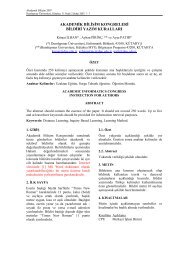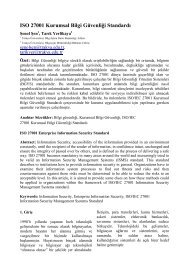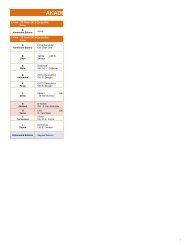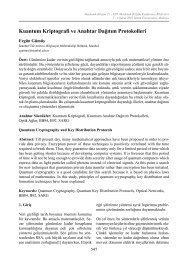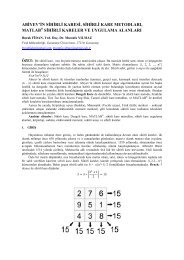- Page 4 and 5:
Tıp Bilişiminde Mobilite Uygulama
- Page 6 and 7:
İnternet ve Sanat, Yeni Medya ve n
- Page 9 and 10:
İnternet ve Sanat, Yeni Medya ve n
- Page 11 and 12:
İnternet ve Sanat, Yeni Medya ve n
- Page 14 and 15:
Akademik Bilişim’10 - XII. Akade
- Page 17 and 18:
Öğrenci ve Öğretim Elemanının
- Page 19 and 20:
Lise Öğrencilerinin Mesleki Yönl
- Page 21 and 22:
Lise Öğrencilerinin Mesleki Yönl
- Page 23 and 24:
Telsiz Duyarga Ağları ile Bir Nes
- Page 25 and 26:
Akademik Bilişim’10 - XII. Akade
- Page 27 and 28:
Kablosuz Algılayıcı Ağlar ve G
- Page 29 and 30:
Akademik Bilişim’10 - XII. Akade
- Page 31 and 32:
Çizge Teorisi, Dağıtık Algoritm
- Page 33 and 34:
Uzaktan Eğitimde Sistem Odası Tas
- Page 35 and 36:
Hizmet İçi Eğitime Farklı Bir Y
- Page 37 and 38:
Hizmet İçi Eğitime Farklı Bir Y
- Page 39 and 40:
Orta Öğretimden Üniversiteye Gel
- Page 41 and 42:
Orta Öğretimden Üniversiteye Gel
- Page 43 and 44:
Uzaktan Eğitimde Yeni Bir Yaklaş
- Page 45 and 46:
Akademik Bilişim’10 - XII. Akade
- Page 47 and 48:
Erişim Ağlarında WIMAX’ın Opt
- Page 49 and 50:
Akademik Bilişim’10 - XII. Akade
- Page 51 and 52:
Türk ve Dünya Hukukunda Bilişim
- Page 53 and 54:
Akademik Bilişim’10 - XII. Akade
- Page 55 and 56:
Mekânsal Bilişime Ontolojik Bir Y
- Page 57 and 58:
Mekânsal Bilişime Ontolojik Bir Y
- Page 59 and 60:
Mekânsal Bilişime Ontolojik Bir Y
- Page 61 and 62:
Temel Bilişim Eğitiminde Enformat
- Page 63 and 64:
Mobi̇ l Peer-To-Pee (P2P) Ağlarda
- Page 65 and 66:
Mobi̇ l Peer-To-Pee (P2P) Ağlarda
- Page 67 and 68:
Bulut Hesaplama Teknolojisi: Mimari
- Page 69 and 70:
Bulut Hesaplama Teknolojisi: Mimari
- Page 71 and 72:
Görevdeş (P2P) Ağlarda Sık Bulu
- Page 73 and 74:
Görevdeş (P2P) Ağlarda Sık Bulu
- Page 75 and 76:
Çevrimiçi Web Analiz Yazılımlar
- Page 77 and 78:
Web Sitelerinde Kullanılabilirlik
- Page 79 and 80:
Akademik Bilişim’10 - XII. Akade
- Page 81 and 82:
Akademik Profil Web SayfasıMehmet
- Page 83 and 84:
Mekansal Veritabanlarında Hızlı
- Page 85 and 86:
Mekansal Veritabanlarında Hızlı
- Page 87 and 88:
Öncül Parola Denetimi Yöntemiyle
- Page 89 and 90:
Öncül Parola Denetimi Yöntemiyle
- Page 91 and 92:
Yazılım Geliştirme Süreçleri v
- Page 93 and 94:
Yazılım Geliştirme Süreçleri v
- Page 95 and 96:
Web Tabanlı CMMI Süreç Yönetimi
- Page 97 and 98:
Akademik Bilişim’10 - XII. Akade
- Page 99 and 100:
Geleneksel Yazılım Mühendisliği
- Page 101 and 102:
Geleneksel Yazılım Mühendisliği
- Page 103 and 104:
Veriambarı Yazılım Geliştirme S
- Page 105 and 106:
Veri Madenciliğinde Temel Bileşen
- Page 107 and 108:
Veri Madenciliğinde Temel Bileşen
- Page 109 and 110:
İş Zekası Çözümleri için Ço
- Page 111 and 112:
İş Zekası Çözümleri için Ço
- Page 113 and 114:
Görüntü İşlemede Yeni Bir Solu
- Page 115 and 116:
Görüntü İşlemede Yeni Bir Solu
- Page 117 and 118:
Bağlantısız Web Uygulamalarını
- Page 119 and 120:
Bağlantısız Web Uygulamalarını
- Page 121 and 122:
Web 2.0 Yeniliklerinin Eğitimde Ku
- Page 123 and 124:
Kurumsal Kimlik Yönetiminde Günce
- Page 125 and 126:
Kurumsal Kimlik Yönetiminde Günce
- Page 127 and 128:
Nesneye Dayalı Programlarla Nesne
- Page 129 and 130:
Normatif Çoklu Etmen Sistemlerinde
- Page 131 and 132:
Normatif Çoklu Etmen Sistemlerinde
- Page 133 and 134:
Birbirleriyle Etkileşim Halinde Bu
- Page 135 and 136:
Birbirleriyle Etkileşim Halinde Bu
- Page 137 and 138:
Gezgin Satıcı Probleminin İkili
- Page 139 and 140:
Gezgin Satıcı Probleminin İkili
- Page 141 and 142:
Akademik Bilişim’10 - XII. Akade
- Page 143 and 144:
Web Tabanlı Sayısal Yarıgrup Hes
- Page 145 and 146:
Web 2.0 Uygulamalarının E-Öğren
- Page 147 and 148:
Web 2.0 Uygulamalarının E-Öğren
- Page 149 and 150:
İstatistiksel Yazılım Geliştirm
- Page 151 and 152:
Arama Motoru OptimizasyonuCoşkun A
- Page 153 and 154:
Arama Motoru OptimizasyonuCoşkun A
- Page 155 and 156:
Üst Seviye Ontolojileri Üzerine B
- Page 157 and 158:
Üst Seviye Ontolojileri Üzerine B
- Page 159 and 160:
Anlamsal Web Politika Dillerinin Ka
- Page 161 and 162:
Anlamsal Web Politika Dillerinin Ka
- Page 163 and 164:
Kural ve Sorgu Örüntülerinin Dü
- Page 165 and 166:
Akademik Bilişim’10 - XII. Akade
- Page 167 and 168:
Eğitimde bir Günlük Uygulaması:
- Page 169 and 170:
Eğitimde bir Günlük Uygulaması:
- Page 171 and 172:
Web 2.0 Teknolojilerinin Eğitim Ü
- Page 173 and 174:
Türkçe Hayat Bilgisi Veri Tabanı
- Page 175 and 176:
Türkçe Hayat Bilgisi Veri Tabanı
- Page 177 and 178:
Türkiye’de İşe Alım Sürecini
- Page 179 and 180:
Akademik Bilişim’10 - XII. Akade
- Page 181 and 182:
Türkiye’de Bilim ve Teknoloji Po
- Page 183 and 184:
Türkiye’de Bilim ve Teknoloji Po
- Page 185 and 186:
Türkiye’de Planlı Kalkınma ve
- Page 187 and 188:
Türkiye’de Planlı Kalkınma ve
- Page 189 and 190:
Bilişim Şuraları, Teknoloji Poli
- Page 191 and 192:
Bilişim Şuraları, Teknoloji Poli
- Page 193 and 194:
Düşük Maliyetli Web Tabanlı Uza
- Page 195 and 196:
Düşük Maliyetli Web Tabanlı Uza
- Page 197 and 198: Mobil Öğrenme Teknolojileri ve Ar
- Page 199 and 200: Akademik Bilişim’10 - XII. Akade
- Page 201 and 202: Öğretim Teknolojileri: Tanımı v
- Page 203 and 204: Akademik Bilişim’10 - XII. Akade
- Page 205 and 206: Braille Alfabesi ile Yazılmış Ka
- Page 207 and 208: Bilgi Güvenliğinde El YazısıBor
- Page 209 and 210: Güvenli İnternet Bankacılığı
- Page 211 and 212: Güvenli İnternet Bankacılığı
- Page 213 and 214: SMTP Protokolü ve Spam Mail Proble
- Page 215 and 216: SMTP Protokolü ve Spam Mail Proble
- Page 217 and 218: Sembolik Hesaplamalar için Mathema
- Page 219 and 220: Genişband Gezgin Haberleşmede Yen
- Page 221 and 222: Üç Boyutlu Çerçeve Yapıların
- Page 223 and 224: Üç Boyutlu Çerçeve Yapıların
- Page 225 and 226: Değişken Kalınlıklı İzotrop P
- Page 227 and 228: Değişken Kalınlıklı İzotrop P
- Page 229 and 230: Katsayıları Özellikli Bant Matri
- Page 231 and 232: Akademik Bilişim’10 - XII. Akade
- Page 233 and 234: Beykent Üniversitesi Yazılım Mü
- Page 235 and 236: Beykent Üniversitesi Yazılım Mü
- Page 237 and 238: Kampüs Ağlarında Etkin Bant Geni
- Page 239 and 240: Kampüs Ağlarında Etkin Bant Geni
- Page 241 and 242: Yabancı Dilde Lisans Öğrenimi i
- Page 243 and 244: Pardus’un 64 bit Mimarisine Port
- Page 245 and 246: Akademik Bilişim’10 - XII. Akade
- Page 247: İnternetteki Etkileşim Merkezi So
- Page 251 and 252: Desert Dune Dynamics And ProcessesL
- Page 253 and 254: Uydu Kentlerin Tasarımı için Bir
- Page 255 and 256: Uydu Kentlerin Tasarımı için Bir
- Page 257 and 258: Kent Kaynaklarının Etkin ve Verim
- Page 259 and 260: Kent Kaynaklarının Etkin ve Verim
- Page 261 and 262: Anadolu Liselerine Öğretmen Atama
- Page 263 and 264: Akıllı Trafik Denetimi ve Yöneti
- Page 265 and 266: Akıllı Trafik Denetimi ve Yöneti
- Page 267 and 268: 3-Boyutlu Sanal Üniversite Oryanta
- Page 269 and 270: Akademik Bilişim’10 - XII. Akade
- Page 271 and 272: Metin İçerikli Türkçe Dokümanl
- Page 273 and 274: Akademik Bilişim’10 - XII. Akade
- Page 275 and 276: Uygurcada Biçimbilimsel Belirsizli
- Page 277 and 278: Sosyal Ağlar ve Profil Yönetimine
- Page 279 and 280: Sosyal Ağlar ve Profil Yönetimine
- Page 281 and 282: Mimarlıkta Yapı Bilgi Modelleme v
- Page 283 and 284: Mimarlıkta Yapı Bilgi Modelleme v
- Page 285 and 286: Kan Damarı Genişliği Değişimin
- Page 287 and 288: Diş Hekimliği Fakültesi Hastanel
- Page 289 and 290: Diş Hekimliği Fakültesi Hastanel
- Page 291 and 292: Ulusal Aşı Bilgi Sistemi: Bir Dur
- Page 293 and 294: Ulusal Aşı Bilgi Sistemi: Bir Dur
- Page 295 and 296: Dermatolojide Tanı Belirlemeye Yar
- Page 297 and 298: Türkiye’de B2B e-Ticaret’i Uyg
- Page 299 and 300:
Türkiye’de B2B e-Ticaret’i Uyg
- Page 301 and 302:
Bazı Kamu Kurumlarında Elektronik
- Page 303 and 304:
Bazı Kamu Kurumlarında Elektronik
- Page 305 and 306:
Akademik Bilişim’10 - XII. Akade
- Page 307 and 308:
Açık Kaynak Kodlu Bilgisayar Enva
- Page 309 and 310:
Dicle Üniversitesi Bilgi İşlem O
- Page 311 and 312:
Aluminyum Kütle İçerisinde İler
- Page 313 and 314:
Aluminyum Kütle İçerisinde İler
- Page 315 and 316:
İş Akış Çizelgeleme Problemi
- Page 317 and 318:
Meslek Liselerinde Mesleki Eğitimi
- Page 319 and 320:
Meslek Liselerinde Mesleki Eğitimi
- Page 321 and 322:
ActiveX ile Eğitsel Bir Web Sayfas
- Page 323 and 324:
Eğitim Amaçlı Debian Web, FTP ve
- Page 325 and 326:
Akademik Bilişim’10 - XII. Akade
- Page 327 and 328:
Yeni Nesil Mobil Öğrenme Aracı:
- Page 329 and 330:
Geoteknik Rapor Hazırlanmasında S
- Page 331 and 332:
Geoteknik Rapor Hazırlanmasında S
- Page 333 and 334:
Excel VBA ile Ankrajlı ve Ankrajs
- Page 335 and 336:
Excel VBA ile Ankrajlı ve Ankrajs
- Page 337 and 338:
Nüfus Tahmin Metotlarının ve Gel
- Page 339 and 340:
Nüfus Tahmin Metotlarının ve Gel



